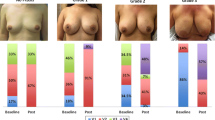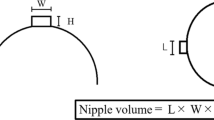Abstract
Background
Nipple-sparing mastectomy (NSM) with immediate breast reconstruction is commonly performed. However, nipple areolar complex (NAC) and mastectomy skin necrosis represent significant complications requiring reoperation and revision. Breast MRI, often obtained for oncologic assessment, can visualize the dominant breast and NAC vascular supply. This study describes the surgical technique utilizing breast MRI blood flow information to preserve important NAC blood supply, thereby, reducing ischemic complications.
Methods
After IRB approval, a prospectively maintained database of all NSM by a single breast surgeon from 2018 to 2020 formed the study group. Preoperative contrast enhanced Breast MRI analysis determined the dominant NAC blood supply. Intraoperatively, the dominant Internal Mammary Artery Perforator (IMP) to the NAC was preserved (IMP-NSM). The IMP-NSM surgical technique preserving the IMP blood flow, evaluation of breast MRI blood flow patterns, surgical findings, and ischemic complications were analyzed.
Results
114 NSM were performed in 74 patients (mean age: 49 years [range, 22–73 years], BMI 25.8 kg/m2 [range, 19–41 kg/m2]). Breast MRI identified the dominant IMP to the NAC in 92%. IMP preservation was successful in 89% (101/114). Necrosis requiring NAC removal occurred in 0.9% (1/114), and skin necrosis reoperation in 1.8% (2/114). Including all post-operative necrosis occurred in 10.5% (12/114), statistically significantly lower compared to the literature for NSM assessing MRI blood flow data without surgical IMP preservation (necrosis 24.4%, p < 0.001) (Bahl et al. in J Am Coll Surg 223(2):279–285, 2016) utilizing Doppler for IMP preservation (necrosis 37%, p < 0.001) (Swistel et al. in Plast Reconstr Surg Glob Open 2(8):e198, 2014) and dividing the IMP in all (necrosis 31.4%, p < 0.001) (Ahn et al. in Eur J Surg Oncol 44(8):1170–1176, 2018).
Conclusions
The IMP-NSM surgical technique preserves the dominant blood supply to the NAC, thereby, decreasing ischemic complications.



Similar content being viewed by others
References
Choi M, Frey JD (2020) Optimizing aesthetic outcomes in breast reconstruction after nipple-sparing mastectomy. Aesthet Surg J 40(Suppl 2):S13–S21
De La Cruz L, Moody AM, Tappy EE, Blankenship SA, Hecht EM (2015) Overall survival, disease-free survival, local recurrence, and nipple-areolar recurrence in the setting of nipple-sparing mastectomy: a meta-analysis and systematic review. Ann Surg Onc 22(10):3241–3249
Moer HR, Ghazi B, Daniel JR, Gasgarth R, Carlson GW (2012) Nipple-sparing mastectomy: technical aspects and aesthetic outcomes. Ann Plast Surg 68(5):446–450
Bailey CR, Ogbuagu O, Baltodano PA et al (2017) Quality-of-life outcomes improve with nipple-sparing mastectomy and breast reconstruction. Plast Reconstr Surg 140(2):219–226
Agha RA, Al Omran Y, Wellstead G, Sagoo H, Barai I, Rajmohan S, Borrelli MR, Vella-Baldacchino M, Orgill DP, Rusby JE (2018) Systematic review of therapeutic nipple-sparing versus skin-sparing mastectomy. BJS Open 3(2):135–145
Bahl M, Pien IJ, Buretta KJ et al (2016) Can vascular patterns on preoperative magnetic resonance imaging help predict skin necrosis after nipple-sparing mastectomy? J Am Coll Surg 223(2):279–285
Swistel A, Small K, Dent B et al (2014) A novel technique of preserving internal mammary artery perforators in nipple sparing breast reconstruction. Plast Reconstr Surg Glob Open 2(8):e198
Ahn SJ, Woo TY, Lee DW et al (2018) Nipple-areolar complex ischemia and necrosis in nipple-sparing mastectomy. Eur J Surg Oncol 44(8):1170–1176
El-Tamer M, Urban C, Rietjens M, et al (2019) Oncoplastic and reconstructive anatomy of the breast, In: Oncoplastic and reconstructive breast surgery, Springer, Cham, pp 13–23
Amanti C, Vitale V, Lombardi A et al (2015) Importance of perforating vessels in nipple-sparing mastectomy: an anatomical description. Breast Cancer (Dove Med Press) 7:179–181
Stolier A (2017) Techniques to avoid nipple and flap necrosis, In: Operative approaches to nipple sparing mastectomy. Springer, Switzerland, pp 101–115
Pestana IA, Jones VM, Velazquez C (2021) Breast reconstruction and nipple-sparing mastectomy: technical modifications and their outcomes over time at an academic breast center. Ann Plast Surg 86(6S Suppl 5):S521–S525
Ng T, Knowles S, Brackstone M et al (2019) Mastectomy flap necrosis after nipple-sparing mastectomy and immediate implant-based reconstruction: an evaluation of tumescence and sharp dissection technique on surgical outcomes. Breast J 6:1079–1083
Chung AP, Giuliano AE (2017) Reducing complications and margin issues with nipple-sparing mastectomy, In: Operative approaches to nipple-sparing mastectomy, Springer, Cham, pp 85–100
Edquilang J, Momeni A, Karin M et al (2020) Outcomes after preservation of the internal mammary artery perforator in nipple sparing mastectomy. Am Soc of Breast Surg 21:210
Karin M, Edquilang J, Momeni A et al (2020) Use of breast MRI to facilitate identification and preservation for the dominant internal mammary perforator blood flow to the nipple in nipple-sparing mastectomy. ANZ J Surg 90(S1):p12-13
Karin M, Wu R, Black C et al (2021) Utilizing breast MRI blood flow data to improve clinical outcomes following skin sparing mastectomy and nipple sparing mastectomy. J Am Col Surgs 233(5(S2)):13
Karin M, Pal S, Silverstein M et al (2022) Nipple sparing mastectomy with internal mammary artery perforator preservation based on breast MRI reduces ischemic complications. the American Society of breast surgeons official proceedings, volume XXIII 2022 Annual meeting scientific session abstracts. Ann Surg Oncol 29:1–330
Harness J (2017) The evolution of nipple-sparing mastectomy (NSM), In Operative approaches to nipple-sparing mastectomy, Springer, Cham, pp 1–10
Coopey S, Smith B (2015) The nipple is just another margin. Ann Surg Oncol 22:3764–3766
Momeni A, Kanchwala S, Sbitany H (2020) Oncoplastic procedures in preparation for nipple-sparing mastectomy and autologous breast reconstruction: Controlling the breast envelope. Plast Reconstr Surg 145(4):914–920
Khavanin N, Fine NA, Bethke KP et al (2014) Tumescent technique does not increase the risk of complication following mastectomy with immediate reconstruction. Ann Surg Onc 21:384–388
Tasoulis MK, Agusti A, Karakatsanis A et al (2019) The use of hydrodissection in nipple- and skin-sparing mastectomy: a retrospective cohort study. Plast Reconstr Surg Glob Open 7(11):e2495
Smith BL, Coopey SB (2018) Nipple-sparing mastectomy. Adv Surg 52:113–126
Tevlin R, Karin M, Momeni A et al (2022) Impact of incision placement on ischemic complications in microsurgical breast reconstruction. Plast Reconstr Surg 149(2):316–322
Acknowledgements
We would like to thank Jarrett Rosenberg, Biostatistician, Stanford University Department of Radiology for statistical analysis and Madeline Verbica, MS, Medical Animator, for figure preparation.
Funding
This research did not receive any specific grant from funding agencies in the public, commercial, or not-for-profit sectors.
Author information
Authors and Affiliations
Corresponding author
Ethics declarations
Conflict of interest
The authors have no financial disclosures or conflicts of interest.
Ethical approval
The study was approved by the Stanford University Institutional Review Board.
Informed consent
Informed consent was obtained for all patients.
Additional information
Publisher's Note
Springer Nature remains neutral with regard to jurisdictional claims in published maps and institutional affiliations.
Accepted for Presentation at World’s Congress of Surgery 2022, Breast Surgery International Prize Abstract Session.
Rights and permissions
Springer Nature or its licensor holds exclusive rights to this article under a publishing agreement with the author(s) or other rightsholder(s); author self-archiving of the accepted manuscript version of this article is solely governed by the terms of such publishing agreement and applicable law.
About this article
Cite this article
Karin, M.R., Pal, S., Ikeda, D. et al. Nipple Sparing Mastectomy Technique to Reduce Ischemic Complications: Preserving Important Blood Flow Based on Breast MRI. World J Surg 47, 192–200 (2023). https://doi.org/10.1007/s00268-022-06764-x
Accepted:
Published:
Issue Date:
DOI: https://doi.org/10.1007/s00268-022-06764-x




